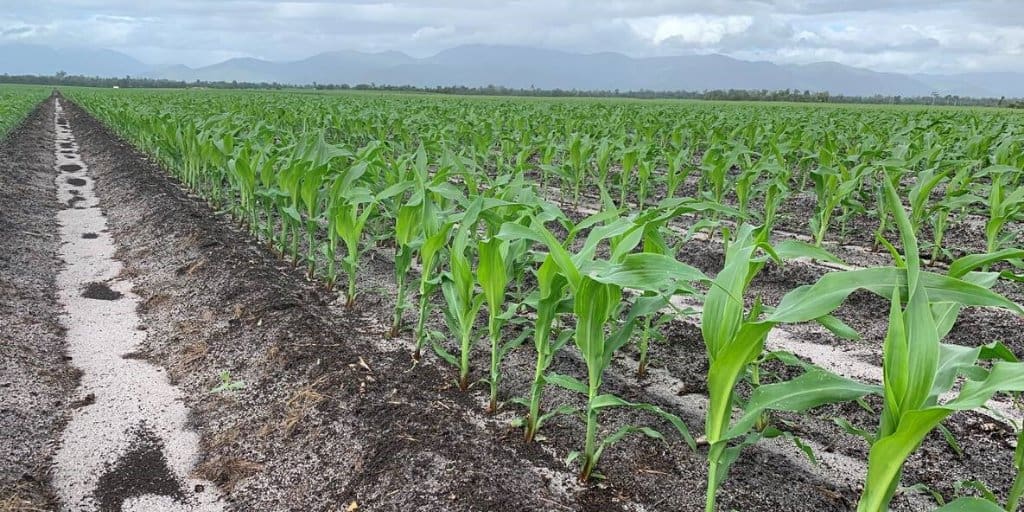
Corn crops like this one at Tully in North Queensland are supplementing production from drought-affected areas in southern Australia. Photo: Pioneer
HARVEST of Australia’s corn crop is all but over, and is forecast by ABARES to produce 207,000 tonnes from 30,000 hectares to make it one of the smallest crops in living memory.
This figure puts the area for the crop grown over the summer at almost half the 59,000ha planted in 2018-19 which yielded 327,000t, and well below the 53,000ha planted in 2017-18 which grew 387,000t.
While developing industries in the tropics — Western Australia’s Kimberley region and the Burdekin in Queensland — have seen production expand over winter months, Australia’s major corn-growing states of New South Wales, Queensland and Victoria have all been impacted by drought.
| 2017-18 ha | 2017-18 tns | 2018-19 ha | 2018-19 tns | 2019-20 ha | 2019-20 tns | |
| Qld | 26,000 | 115,000 | 28,000 | 88,000 | 10,000 | 50,000 |
| NSW | 20,000 | 190,000 | 21,000 | 147,000 | 10,000 | 90,000 |
| Vic | 5,000 | 60,000 | 7,000 | 66,000 | 8,000 | 50,000 |
| TOTAL | 51,000 | 365,000 | 56,000 | 301,000 | 28,000 | 190,000 |
Table 1: Corn area and production in major-producing states. Source: ABARES
Needs covered
Despite the challenges of drought, Australia has grown enough corn to meet processing needs for corn chips and breakfast cereals, and produce a small area for silage and stockfeed.
Lachlan Commodities Forbes-based trading manager Andrew Cogswell manages some of Australia’s human-consumption supply chain, and estimates up to 97 per cent of this season’s has been grown on bore water.
“Overall, we saw about 25pc of what we would normally see in eastern Australia because of the drought.”
“It was processing or gritting corn for export — maybe 30,000-40,000t — that has missed out, and stockfeed that would have taken up additional volume.”
Taking some of the pressure off the small crop was January’s closure of the Ingredion wet mill in Sydney’s Lane Cove, which removed 45,000t of demand from the market.
While the Kimberley is expected to again produce bulk export tonnage this winter, exports of corn from the crop just harvested in south-eastern Australia have been restricted by limited volume to containers.
Rain in late December and January on the Darling Downs of southern Queensland allowed some late planting of dryland corn.
Growers who were able to harvest the grain achieved extremely high prices of up to $600/t delivered to local stockfeed millers, while growers selling non-contracted corn in the Riverina of southern NSW were getting more than $500/t in some cases.
Limited water
While some growers from central Queensland to Victoria had good growing seasons, Mr Cogswell said variable temperature, and a lack of early in-crop rain to supplement irrigation, made 2019-20 a difficult season for most.
“Even guys that planted in October had some trouble, with the temperature going from hot to cold, and that stunted early growth.
“On average, harvest was back for a few weeks, so late March-early April instead of late February-early March.”
A small number of crops sown late in NSW were still standing when recent rains came, and they are not likely to be harvested before August.
“When the weather’s cold, it’s hard to get the moisture down to where it needs to be, so they’ll go through winter okay and they’ll be harvested when they dry down.”
Mr Cogswell said the lower price of water per megalitre (ML) meant corn area could well pick up when the planting window opens in spring.
“The water price is down a lot, so maybe $250/ML, when it got up to $780/ML.
“Once you get to $450/ML, you see less demand for water to grow corn.
“It really depends on the next run of allocation, and how much demand there is for permanent plantings.”
These are mainly nut trees, which have become big users of water in the Murrumbidgee Irrigation Area in particular.
Grain Central: Get our free daily cropping news straight to your inbox – Click here

HAVE YOUR SAY